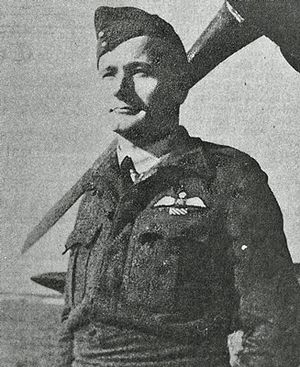George Powell-Shedden facts for kids
Quick facts for kids
George Ffolliott Powell-Shedden
|
|
|---|---|
 |
|
| Nickname(s) | "FoFo" |
| Born | 1 April 1916 Cowes, Isle of Wight |
| Died | 31 October 1994 (aged 78) London, England |
| Allegiance | United Kingdom |
| Service/ |
Royal Air Force |
| Years of service | 1934–1961 |
| Rank | Group captain |
| Commands held | RAF Jever (1952–54) No. 29 Squadron (1944) Malta Night Fighter Unit (1941) No. 615 (County of Surrey) Squadron (1941) |
| Battles/wars | Second World War |
| Awards | Distinguished Service Order & Bar Distinguished Flying Cross |
George Ffolliott Powell-Shedden (born April 1, 1916 – died October 31, 1994) was a brave pilot for the Royal Air Force. He flew during the famous Battle of Britain and later led many important missions. He was also an Olympic bobsledder, competing for Britain in the late 1940s.
Contents
Early Life and Training
George Ffolliott Powell was born on April 1, 1916, in Cowes on the Isle of Wight. His father was Lieutenant Colonel Richmond Ffolliott Powell. George was the youngest of three brothers.
He went to Wellington College. After school, he joined the Royal Military Academy, Woolwich. Later, he switched to the Royal Air Force College Cranwell. He officially became an officer in the Royal Air Force on December 19, 1936.
Flying for the Royal Air Force
In 1937, George Powell-Shedden joined No. 47 Squadron RAF. He flew Vickers Vincent planes from Khartoum. In 1939, he moved to No. 33 Squadron RAF. This fighter squadron used Gloster Gladiator biplanes to help keep peace in Palestine.
Heroism in the Battle of Britain
During the Battle of Britain, Powell-Shedden was a flight commander. He served in No. 242 Squadron RAF, led by the famous Group Captain Douglas Bader. Even though he was quite tall for a Hawker Hurricane cockpit, he was known as a very good pilot.
Powell-Shedden joined the squadron in June 1940. He shot down at least four enemy aircraft during this time.
On September 15, 1940, known as Battle of Britain Day, Powell-Shedden was reported missing. He had shot down one German bomber. While chasing another, a Messerschmitt Bf 109 fighter attacked his Hurricane. His plane caught fire. When he parachuted out, he hit the tail of his plane and dislocated his shoulder.
After the Battle of Britain, Powell-Shedden became a flight commander for No. 258 Squadron RAF. In April 1941, he took command of No. 615 (County of Surrey) Squadron.
Defending Malta
In July 1941, Powell-Shedden was sent to the island of Malta. There, he created the Malta Night Fighter Unit. This small group of Hurricanes worked with searchlights and anti-aircraft guns to protect the island at night.
He was promoted to squadron leader in September 1941. In December, he received the Distinguished Flying Cross for his bravery.
Missions for D-Day
In January 1944, he returned to flying missions. He joined No. 96 Squadron RAF, which flew Mosquito planes. Later, he took command of No. 29 Squadron RAF. This squadron flew Mosquito planes on dangerous low-level night missions. They flew these missions before and after D-Day.
He received a Bar to his Distinguished Service Order on April 27, 1945. This award was for his excellent leadership during many risky missions.
Later Air Force Roles
In 1952, Powell-Shedden took command of RAF Jever in Germany. He was promoted to group captain on January 1, 1954. From 1954 to 1957, he worked on the operational staff in Naples. He then moved to the Air Ministry in 1958. He retired from the Royal Air Force in 1961.
Olympic Bobsledder
George Powell-Shedden was also a bobsledder. He competed for Britain in the late 1940s. At the 1948 Winter Olympics in St. Moritz, he finished 15th in the four-man bobsled event. His teammates were James Iremonger, Edgar Meddings, and Richard Jeffrey.
Later Life
After retiring from the RAF in 1961, Powell-Shedden joined the Stock Exchange. He also farmed in Buckinghamshire. He was married twice and had a son, Henry, and a daughter, Angela. He passed away on October 31, 1994, in London.

